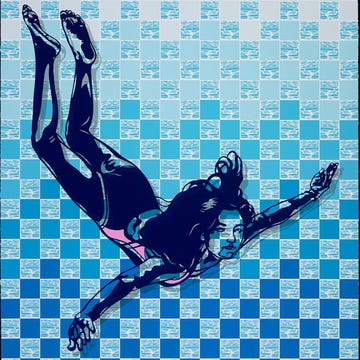Rina Ayuyang’s graphic novel The Man in the McIntosh Suit is a noir replete with mistaken identities, vanishing paramours, and the notes of classic tunes, which dreamily waft through the panels like smoke at a seedy dive bar. The story follows the exploits of Bobot, a Filipino American migrant worker in Depression-era California. Trained to practice law, Bobot must pick fruit at a Watsonville farm, until he finds himself compelled to travel to San Francisco in search of his estranged wife.
This essay was adapted from the Alta newsletter, delivered every Thursday.
SIGN UP
While noir antiheroes like Sam Spade and Philip Marlowe are able to do just about whatever they please, Bobot must contend with being a Filipino American in a time and place where racism run rampant.
This is a noir of a different color, sometimes literally, thanks to Ayuyang’s vibrant illustrations.
“I knew this was going to be a story set in the time period that’s usually depicted in black and white, but I wanted to keep my style of using color to evoke certain emotions,” says Ayuyang. Color fills the panels. Bobot’s enigmatic love interest, for example, is depicted in rich magenta, a striking choice that also evokes the eerie green light that bathes Kim Novak’s character during a critical scene in Hitchcock’s San Francisco–set Vertigo.
Eagle-eyed noir fans may find certain panels echoing beloved works like Dark Passage and, naturally, The Maltese Falcon, which served as inspiration for the artist as she completed her work while isolated during the COVID-19 pandemic.
“What really prompted me to get this project moving, aside from COVID, was my love for the whole feel of noirs: the dialogue, how they’re shot, the storylines,” Ayuyang says. “At first, I wanted to do a simple story, basically a pure homage to Nick and Nora from The Thin Man but with a character based on my dad–slash–Humphrey Bogart.”
That simple story grew more complex as she layered in the history of Filipino immigrants in California. “I knew I had to address the political situation that was going on at the time, so I set the story at the tail end of 1929, when the first leg of the second wave of Filipino immigration in America was at its highest and causing a lot of racial tensions with white Americans,” she explains.
“There was this hugely hostile attitude towards them, and Filipinos are a huge community in California, but we aren’t fully represented in the media. [Our] history in America matters, and I wanted to have it in there.”
Another constant for Ayuyang is music, which also features prominently in her 2018 graphic memoir, Blame This on the Boogie. McIntosh contains a veritable mixtape of period songs, which find their way into the narrative, from Irving Berlin’s jaunty “Blue Skies” to Filipino tracks like “La Bella Filipina” by Ignacio Massaguer.
“I knew that music would be a huge part of it, like with my first book, because I always try to put the cinematic qualities of film into my books so that you’re immersed with sound and visuals and all of that,” Ayuyang says. “It’s hard to do in a book, but when you can create that whole mood, it’s like an escape from the world.”
Ayuyang isn’t done with the world of McIntosh just yet. She ends the book with “To Be Continued,” a promise that Bobot will not recede into the fog.
“There are a lot of questions that still need to be answered,” Ayuyang says. “Once I wrote this book, I knew that there would be more books to come.”•
Zack Ruskin is a freelance reporter living in San Francisco. His regular beats include weed, music, literature, comedy, and drag. He’s written the cannabis column “Chem Tales” for SF Weekly since 2016 and reviews new music releases for Variety. His byline has also appeared in Vanity Fair, Merry Jane, the San Francisco Chronicle, Alta, Billboard, Entertainment Weekly, Cannabis Now, and Marin Magazine.












